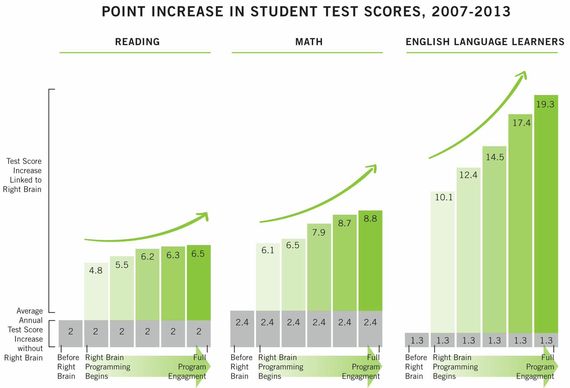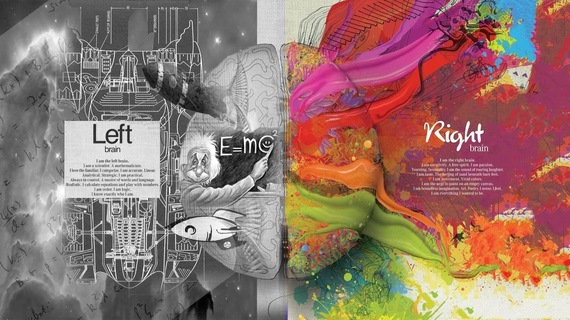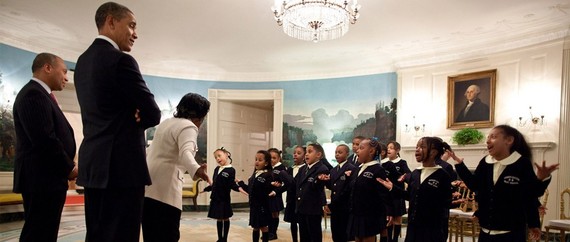This article first published on the
Huffington Post
John M. Eger
Director of
the Creative Economy Initiative at San Diego State University (SDSU) is
also the Van Deerlin Endowed Chair of Communications and Public Policy
Tomorrow the
Right Brain Initiative (RBI) serving the greater Portland region
releases
a report that confirms "There is a meaningful and quantifiable link
between integrated arts education and student learning," specifically:
• Students' reading and math scores increase at least 2.5 times
more than the average annual rate of increase.
• This growth is even greater for English Language Learners. Student's scores
increased 10 times more after schools partnered with Right Brain.
• For all children, scores continued to rise as schools engaged more deeply
with the Initiative, with a particularly large rate of increase for English
Language Learners.

The study released today tracking student progress over a 5 year period, was conducted by
WolfBrown, a leading research and advisory firm serving a wide range of foundations, public agencies and charitable organizations.
RBI
was launched in 2008 by a unique collaboration of artists, art and
cultural organizations, school districts, governments, businesses and
donors who believed in the concept of "arts integration", using the arts
as a catalyst for teaching across the curriculum, and in the process
creating a truly interdisciplinary curriculum.
RBI agreed to
embrace arts integration as few other regions have done. Other than
teacher retraining, their approach is not more classes, more arts or
music, more anything. That would be nice but, frankly, there is not
money for doing anything more, only doing things differently.
As
the RBI Study shows, the initiative is working. According to Rebecca
Burrell, Outreach Specialist at RBI, we are convinced that it is "art
integration that makes the difference" in the progress being made in the
schools.
This school year, RBI is bringing arts learning to over
20,000 students at 59 K-8 schools in seven districts. The arts
integration education initiative serves every K-8 classroom serving
Clackamas, Multnomah and Washington Counties, including the metro area
of Portland, Oregon, and its changing teachers as well as students. Is
is also making it easier for them to embrace the principles of the
Common Core being adopted by schools districts around the nation.
This
is auspicious news to be sure, but while this represents a tremendous
show of progress toward creating real world interdisciplinary curricula,
the work is not over. As most advocates of the arts and arts
integration know, the struggle to recognize the important role of the
arts, and art integration has been extremely difficult.
As far
back as 2002, a unique consortium of arts organizations expressed it in a
report called "Authentic Connections." They said then that such
interdisciplinary work in the arts enabled students to "identify and
apply authentic connections, promote learning by providing students with
opportunities between disciplines and/or to understand, solve problems
and make meaningful connections within the arts across disciplines on
essential concepts that transcend individual disciplines."
That
was mostly anecdotal though well founded. There remained many, simply
put too many, people that saw art as nice but not necessary...children's
art, even less valuable. Sadly, that is true even today perhaps because
many people don't take the term "arts" seriously. It's soft, not
muscular unlike the sciences where there is more certainty, more
equations, formulas etc. Art by contrast is uncertain.
Unfortunately, we live in a "left brain world" says noted neuroscientist, Ian McGilchrist, in a
commentary for The Wall Street Journal:
"There is an inevitable rise in bureaucracy, with
paper replacing people, and experience increasingly virtualized. In
going all out for what we believe will be our own happiness, we exploit
the world and see ourselves as alien to it, rather than seeing that our
happiness depends on being part of it, and therefore on helping it to
thrive. This is the world of the left hemisphere, ever keen on control".
The
right, as well as the left hemisphere of the brain cry out for
nurturing, and the future of America depends on reinventing the way we
think, and in the process, how education is redefined.
Fortunately,
more neuroscientists, psychologists, educators and others are finding
that the arts help nurture the right hemisphere of the brain. This is
exactly what the more left brained curriculum needs to create the new
thinking skills leading to creativity.

We
now know a lot more about learning and know "arts integration" works.
The President's Committee on the Arts and Humanities, in a report
called "Reinvesting in Arts Education: Winning America's Future Through
Creative Schools." has said as much after spending years of research and
study.
According to the Committee report, "Cutting-edge studies
in neuroscience have been further developing our understanding of how
arts strategies support crucial brain development in learning."
The
Turnaround Arts program
of the Obama Administration provides yet more evidence that art and art
integration works. As the First Lady Michelle Obama, Honorary Chair of
the President's Committee, said:
"The Turnaround Arts
program has exceeded not just our expectations, but our wildest hopes
and dreams. With the help of this program and some School Improvement
Grants, math and reading scores have gone up in these schools...
attendance is up, enrollment is up...parent engagement is up...
suspensions have plummeted...and two of the schools in our pilot
improved so dramatically that they are no longer in turnaround status.
And today, the students in these schools are engaged in their education
like never before."

Author
and educator Mihaly Csíkszentmihályi calls such total emersion in a
task, FLOW...a " mental state of operation in which a person in an
activity is fully immersed in a feeling of energized focus, full
involvement, and success in the process of the activity." Dr Richard
Restak in his book, The New Brain seems to agree. He uses the words
"plastic" and "malleable" to describe the brain. He believes that we can
be creative by acquiring the right series of "repertoires;" that we can
"preselect the kind of brain (we) will have by choosing richly valued
experiences."
As demand for a new workforce to meet the
challenges of a global knowledge economy is rapidly increasing, few
things could be as important in this period of our nation's history than
reinventing education.
While not everyone sees the Arts as the
answer to America's economic prosperity, and in Washington, D.C. the
differences in viewpoints become a matter of contention at the outset of
any issue regardless of the merits. But the evidence is mounting, in
Portland and in other communities, in favor of blurring the lines
between art and science, and developing more real world
interdisciplinary courses.
Follow John M. Eger on Twitter:
www.twitter.com/jeger62





